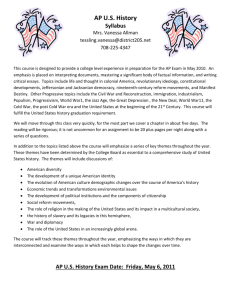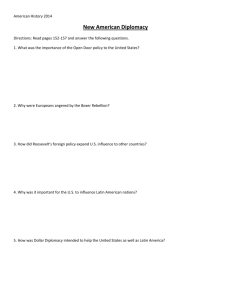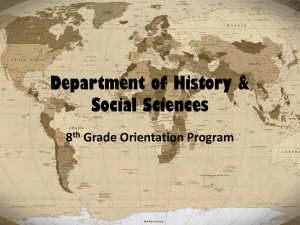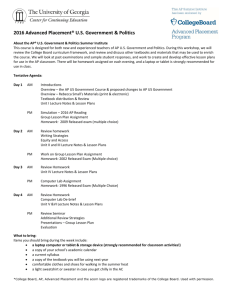ADVANCED PLACEMENT UNITED STATES HISTORY
advertisement
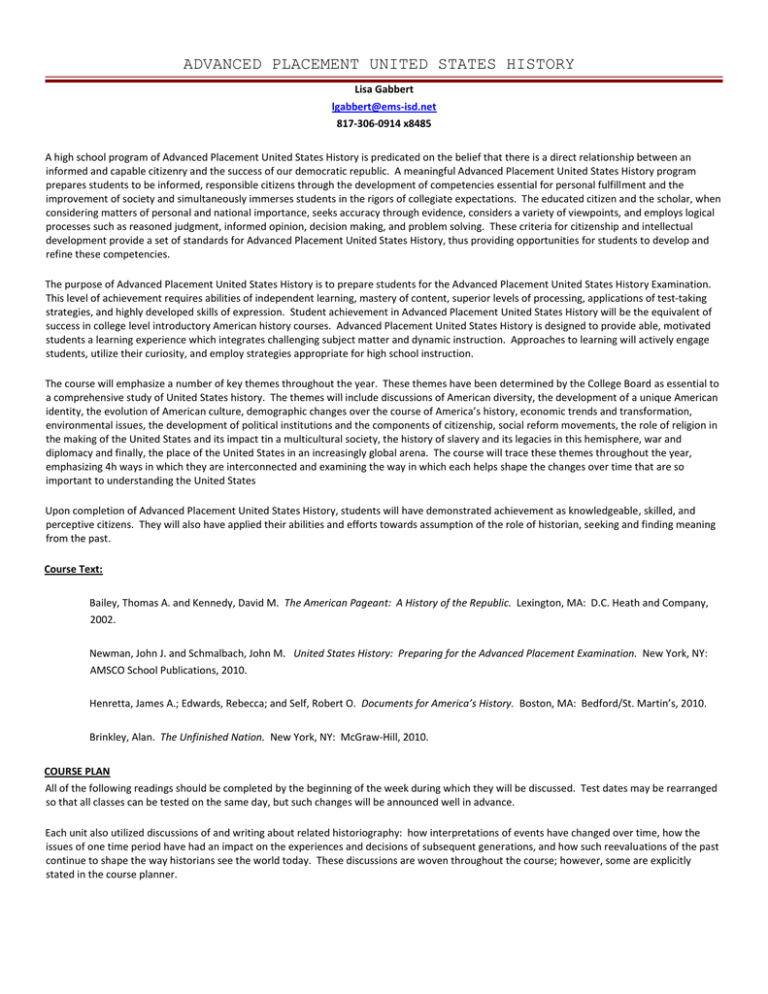
ADVANCED PLACEMENT UNITED STATES HISTORY Lisa Gabbert lgabbert@ems-isd.net 817-306-0914 x8485 A high school program of Advanced Placement United States History is predicated on the belief that there is a direct relationship between an informed and capable citizenry and the success of our democratic republic. A meaningful Advanced Placement United States History program prepares students to be informed, responsible citizens through the development of competencies essential for personal fulfillment and the improvement of society and simultaneously immerses students in the rigors of collegiate expectations. The educated citizen and the scholar, when considering matters of personal and national importance, seeks accuracy through evidence, considers a variety of viewpoints, and employs logical processes such as reasoned judgment, informed opinion, decision making, and problem solving. These criteria for citizenship and intellectual development provide a set of standards for Advanced Placement United States History, thus providing opportunities for students to develop and refine these competencies. The purpose of Advanced Placement United States History is to prepare students for the Advanced Placement United States History Examination. This level of achievement requires abilities of independent learning, mastery of content, superior levels of processing, applications of test-taking strategies, and highly developed skills of expression. Student achievement in Advanced Placement United States History will be the equivalent of success in college level introductory American history courses. Advanced Placement United States History is designed to provide able, motivated students a learning experience which integrates challenging subject matter and dynamic instruction. Approaches to learning will actively engage students, utilize their curiosity, and employ strategies appropriate for high school instruction. The course will emphasize a number of key themes throughout the year. These themes have been determined by the College Board as essential to a comprehensive study of United States history. The themes will include discussions of American diversity, the development of a unique American identity, the evolution of American culture, demographic changes over the course of America’s history, economic trends and transformation, environmental issues, the development of political institutions and the components of citizenship, social reform movements, the role of religion in the making of the United States and its impact tin a multicultural society, the history of slavery and its legacies in this hemisphere, war and diplomacy and finally, the place of the United States in an increasingly global arena. The course will trace these themes throughout the year, emphasizing 4h ways in which they are interconnected and examining the way in which each helps shape the changes over time that are so important to understanding the United States Upon completion of Advanced Placement United States History, students will have demonstrated achievement as knowledgeable, skilled, and perceptive citizens. They will also have applied their abilities and efforts towards assumption of the role of historian, seeking and finding meaning from the past. Course Text: Bailey, Thomas A. and Kennedy, David M. The American Pageant: A History of the Republic. Lexington, MA: D.C. Heath and Company, 2002. Newman, John J. and Schmalbach, John M. United States History: Preparing for the Advanced Placement Examination. New York, NY: AMSCO School Publications, 2010. Henretta, James A.; Edwards, Rebecca; and Self, Robert O. Documents for America’s History. Boston, MA: Bedford/St. Martin’s, 2010. Brinkley, Alan. The Unfinished Nation. New York, NY: McGraw-Hill, 2010. COURSE PLAN All of the following readings should be completed by the beginning of the week during which they will be discussed. Test dates may be rearranged so that all classes can be tested on the same day, but such changes will be announced well in advance. Each unit also utilized discussions of and writing about related historiography: how interpretations of events have changed over time, how the issues of one time period have had an impact on the experiences and decisions of subsequent generations, and how such reevaluations of the past continue to shape the way historians see the world today. These discussions are woven throughout the course; however, some are explicitly stated in the course planner. ADVANCED PLACEMENT UNITED STATES HISTORY Unit I: 1491-1754 August 25 to September 26: American Pageant Chapter 1: New World Beginnings, Pre-Columbian Cultures, Early Explorations, Roots of Slavery, Spanish and French Claims, the Rise of Mercantilism Chapter 2: The Planting of English America, The Chesapeake and Southern English Colonies, Ties with Caribbean Economies, British Mercantilism Chapter 3: Settling the Northern Colonies, New England and the Puritans, Religious Dissent, Colonial Politics and Conflict with British Authority, the Middle Colonies Chapter 4: American Life in the 17th C., Tobacco and Rice Colonies, African-American Culture, Colonial Family Life, Dissent in New England and the Witch Trials DBQ: Chesapeake v. New England Colonies Timed Classroom Essay/Additional Guidance for Writing DBQ Upon Scheduling Free Response Essay: Compare and contrast the ways in which economic development affected politics in Massachusetts and Virginia in the period from 1607-1750. Mock Witch Trials Students will participate with several claims of witch craft – trial will be conducted with role play of actual women and men that were accused in Salem and other areas of New England Unit II: 1754-1800, September 29 to October 17 The American Revolution Pageant Chapter 5: Colonial Society on the Eve of Revolution, Immigration and Demographic Change, the Atlantic Economy, the Great Awakening, Education and Culture, Colonial Politics Chapter 6: The Duel for North America, Colonial Involvement in British Imperial War, Consequences of the French and Indian War, and the Proclamation of 1763 Chapter 7: The Road to Revolution, Roots of Revolution and the Role of Mercantilism, End of Salutary Neglect, Failure of Diplomacy, First Conflicts Chapter 8: America Secedes from the Empire, The American Revolution, Wartime Diplomacy, Life on the Home Front, Women and the War, the Impact of the War on the Institution of Slavery Chapter 9: The Confederation and the Constitution, The Articles of Confederation and the Constitution, the Role of the Enlightenment, Slavery and Religion in the Political Process, Wartime Diplomacy Chapter 10: Launching the New Ship of State, Early National Politics and Economics, Diplomacy During the French Revolution, the Making of the Office of the Presidency Primary Source Analysis Documents for American History: Thomas Paine’s Common Sense The Declaration of Independence Varying Viewpoints Discussion: Adam Smith’s An Inquiry into the Nature and Causes of the Wealth of Nations v. Peter Oliver’s Origin and Progress of the American Rebellion Students will analyze both writing, choose a position and defend that position through historical debate. All opinions must be supported with historical evidence and analysis; grades are determined by student’s ability to formulate and defend arguments which is essential to the writing process. ADVANCED PLACEMENT UNITED STATES HISTORY Free Response Essay: “The United States Constitution of 1787represented an economic and ideological victory for the traditional American political elite.” Assess the validity of the statement for the period 1781-1789. Unit Exams: Age of Exploration to Proclamation of 1763 First Six Weeks Exam: Exploration to Independence Exams will be multiple-choice and each will have a writing element modeling the short answer format presented on the redesigned AP Exam. Unit III: 1800-1848, October 20 to November 14 The New Republic Comes of Age Chapter 11: Triumphs and Travails of Jeffersonian Democracy, the Revolution of 1800, the Marshall Court, Diplomacy of Jefferson and Madison, the Embargo Act, Acceleration of Westward Expansion Chapter 12: The Second War for Independence, Nationalism and Sectionalism, The War of 1812, The Era of Good Feelings, The American System, the Diplomacy of Expansion, Forging a New National Identity Chapter 13: The Rise of mass Democracy, Jacksonian Democracy and the Whigs, National Policy toward American Indians, the Era of the “Common Man,” Expansion with the Texas Revolution, Slavery and Sectionalism Varying Viewpoints Discussion: Was the growing sectionalism within the United States fostered by greater nationalism? Introduce argument by examining Henry Steele Commager’s Documents of American History. Primary Source Analysis: The Constitution of the United States of America Federalist Paper No. 10, 51, 54 “Washington’s Farewell Address” “Kentucky and Virginia Resolutions” Marbury v. Madison (accompanied by recent scholarship: The Most Defining Case) Seneca Falls Declaration of Sentiments Multiple Causation: Groups will answer and debate complex questioning surrounding 1. Republican Ideologies 2. The Framework of the Constitution Unit IV: 1844-1877, November 17 to December 12 America’s Sectional Divide Ruptures Chapter 14: Forging the National Economy, the Rise of the Market Economy, Immigration and the Increase in Nativism, Women in the Workplace, the Factory System, the Transportation Revolution, Expansion West Chapter 15: the Ferment of Reform and Culture, The Second Great Awakening, Women’s Role in Reform Movements, Creation of a National Culture, Advances in Education and the Sciences Chapter 16: The South and Slavery Controversy, Cotton Culture, Southern Society and the Impact of the Plantation System, the Rise of the Abolitionist Movements Chapter 17: Manifest Destiny and its Legacy, Expansion under Polk, Manifest Destiny, War with Mexico Chapter 18: Renewing the Sectional Struggle, Popular Sovereignty, the Compromise of 1850 and the Fugitive Slave Law, the Economics of Expansion Chapter 19: Drifting Toward Disunion, Abolition in the 1850s, Impact of Dred Scott, the financial Panic of 1857, Political Crisis in the Election of 1860, the coming of the Civil War Chapter 20: Girding the War, Wartime Diplomacy, Economic Changes in Both the North and South, Women and the War, Issues of Civil Liberties in Wartime ADVANCED PLACEMENT UNITED STATES HISTORY Chapter 21: The Furnace of the Civil War, The Peninsula Campaign, the Anaconda, the War in the West, Sherman’s March, Appomattox, the Emancipation Proclamation, the Legacy of War in the North and South DBQ: Diplomacy of Jefferson v. Madison Primary Source Analysis: The Monroe Doctrine The Liberator (first issue) Seneca Falls Declarations of Sentiments John C. Calhoun “The Slavery Question” Dred Scott v. Sanford Lincoln Packet: First Inaugural Address, Emancipation Proclamation, Gettysburg Address Unit Exam: Cumulative Exam Exams will be multiple-choice and each will have a writing element modeling the Long Essay as described in the APUSH redesign. Unit V: 1865-1898, December 15 to January 30 Transformation of the United States Chapter 22: The Ordeal of Reconstruction, the Politics and Economics of Reconstruction, Experiences of Freedmen, the Rise of the Bourbon South and the Fate of Reconstruction, Impeachment Politics and the Balance of Power Chapter 23: Political Power in the Gilded Age, the Rise of Big Businesses and the Role of Business in Politics, Class and Ethnic Conflict, the Rise of Jim Crow Laws Chapter 24: Industry Comes of Age, Era of the Robber Barons, the Lives of the Working Class and the Growth of Unionism, Government and Politics of Regulation, the United States in the World Economy. Chapter 25: America Moves to the City, Urbanization, New Waves of Immigration, Renewed Instances of Nativism, Cultural Life in Urban America, the “New Woman,” African­American Push for Expanded Civil Rights Chapter 26: The Great West and the Agricultural Revolution, the Close of the Frontier and Its Impact, Industrialization of Agriculture and Political Dissent Among Farmers Chapter 27: Empire and Expansion, American Expansion Overseas, a New Age of Imperialism, the Spanish-American War, the Open Door Policy, America on the World Stage Chapter 28: Progressivism and the Republican Roosevelt, Progressive Reform and the Trusts, Demographics of Urbanization and the Resulting Political Impact, “Dollar Diplomacy” and Environmental Issues Varying Viewpoints Discussion: Examine the debates between radicals such as Thaddeus Stevens and moderates like Lyman Trumball. Introduce by analyzing debates published in the Congressional Globe. Students will role play and defend their assigned perspective. Primary Source Analysis: Populist v. Progressivism – Diverging Perspectives Analysis – Students will discuss and debate the efficacy of the Progressive Movement Walt Whitman, Democratic Vistas Andrew Carnegie, Wealth Samuel Gompers, “Letter o Labor in Industrial Society” Booker T. Washington, “Atlanta Exposition Address” Free Response Essay: Explain why and how the role of the federal government changed as a result of the Civil War with respect to TWO of the following during the period 1860-1877: Race Relations Economic Development Westward Expansion ADVANCED PLACEMENT UNITED STATES HISTORY Semester Exams: Multiple Choice & Four Short Answer Questions January 16-18 Unit VI: 1890-1945, February 2 to March 6 America at Home and Abroad Chapter 29: Wilsonian Progressivism at Home and Abroad, the New Freedom Versus the New Nationalism, Progressive Economic Reform, Diplomacy of Neutrality Chapter 30: The War to End All Wars, War in Europe and War on the Homefront, Propaganda and Civil Liberties, the Politics Behind the Making of the Treaty of Versailles and its Rejection by the U.S. Senate Chapter 31: American Life in the Roaring Twenties, the “Red Scare,” and Immigration Issues, a Mass­Consumption Economy, the Jazz Age, and the Harlem Renaissance, Traditionalism v. Modernism Chapter 32: The Politics of Boom and Bust, Isolationism in the 1920s, Foreign Debt and Diplomacy, the Coming of the Great Depression Chapter 33: The Great Depression and the New Deal, FDR and “recovery, relief, reform,” Demographic Changes Associated with the Depression, Cultural Changes in the 1930s, the Supreme Court and the Balance of Political Power in Government Chapter 34: FDR and the Shadow of War, Attempts at Neutrality and Isolation, Diplomacy and Economics of the Pre-War Years, the Move to War Following Pearl Harbor’ Chapter 35: America in World War II, The War in Europe and in the Far East, the Home Front, Changes for Women and Minorities During the War, the Decision to Use the Atomic Bomb and its Consequences Varying Perspectives Discussion: Is isolationism justified? William E. Borah’s, “Speech on the League of Nations” and Richard Hofstdter’s, Great Issues in American History each examine the American foreign policy of isolationism. Have students research and discuss the validity of this stance in American history; arguments must be supported with historical evidence and analysis. Primary Source Analysis: William Jennings Bryan, “Cross of Gold” Speech Alfred T. Mahan, The United States Looking Outward Theodore Roosevelt “Corollary to the Monroe Doctrine” and “The New Nationalism” Woodrow Wilson, The Old Order Changeth Woodrow Wilson Packet: “War Message to Congress” and “Fourteen Points” Herbert Hoover, “Rugged Individualism” Franklin Roosevelt, First Inaugural Address” DBQ: Progressive Movement’s Ability to Bring National Change Unit Exam: Exams will be multiple-choice and each will have a writing element modeling the short answer questions presented by the APUSH redesign. Unit VII: 1945-1980, March 19 to April 3 America as an International Force Chapter 36: The Cold War Begins, Postwar Prosperity and the Baby Boom, Communism and Containment, Diplomacy and the Marshall Plan, the Korean War, and the Red Scare, the United States as a World Power Chapter 37: The Eisenhower Era, Consumer Culture in the 1950s, the Civil Rights Revolution, McCarthyism, Cold War Expansion, the Space Race, Postwar Literature and Culture Chapter 38: The Stormy Sixties, The Cold War Continues, Expansion of the War in Vietnam, the Civil Rights Revolution and Evolution, Johnson and the Great Society, Immigration and Demographic Changes. Chapter 39: The Stalemated Seventies, Rise of Conservatism, Economic Stagnation, Crisis Over Presidential Power, ADVANCED PLACEMENT UNITED STATES HISTORY Environmental Issues, Feminism and the Women’s Movement, Civil Rights and Affirmative Action, Foreign Policy and the Issue of Oil Multiple Causation: Franklin D. Roosevelt Discussion: Wartime Diplomacy and the “Choice” – Debating the Past Primary Sources included for preparation: The Quarantine Speech and Four Freedoms Speech Primary Source Primary Source Analysis: George Kennan, Sources of Soviet Conduct William Faulkner, Acceptance Speech for the Nobel Prize John Kennedy, Inaugural Address Martin Luther King, Jr., Letter from a Birmingham Jail and “I Have a Dream” speech Lyndon B. Johnson, “The Great Society” speech Six Degrees of Separation: From Containment to “Tear Down This Wall” Using notes and primary sources, students construct a time line of the Civil Rights Movement from Reconstruction to the 1970s and annotate key turning points in the movement. Unit Exam Exams will be multiple-choice and each will have a writing element modeling the short answer questions presented by the APUSH redesign. Unit VIII: 1980-Present, April 6 to April 17 Toward the Present Chapter 40: The Resurgence of Conservatism, Reagan and the “New Right,” the End of the Cold War, Reagonomics, Politics and the Supreme Court, Globalization, War and Diplomacy in the Middle East Chapter 41: America Confronts the Post-Cold War Era, The Clinton Era, Post-Cold War Politics and Foreign Policy, the Contested Election of 2000, the Attack on the World Trade Center and America Post 9/11 Chapter 42: The American People Face a New Century, Demographic Changes, Changes in the Family, Immigration and Related Issues, a Multicultural Society, the High-Tech Economy, America in a Global Context Primary Source Analysis: Media Revolution Packet: Lyndon B Johnson, “The Power of the Media” and Edward R. Murrow, “Television and Politics” Roe v. Wade Ronald Reagan, Inaugural Address 1981/1985 George W. Bush, Washington National Cathedral Prayer Service, September 2001 George W. Bush, Joint Session of Congress, September 2001 Rudy Giuliani, Farewell Address, 2001 Practice AP Exam – Complete Mock Exam for Students Review Boot Camp: 1. Colonial America to American Revolution Discuss DBQ: Did American Revolution fundamentally change American Society? 2. Confederation to Civil War Multiple Choice Focus Varying Viewpoints Discussion: State v. Federal Governments 3. Reconstruction to World War I Discuss DBQ: Effectiveness of the Progressive Era ADVANCED PLACEMENT UNITED STATES HISTORY 4. Depression to Present Discuss DBQ: International and Domestic Challenges for US from 1968-1974 AP TEST MAY 8th Grading Assignments (30% of six weeks grade): Students will be assigned reading from textbooks and articles. Students will read and take notes for use studying for later assessments. Since the course covers so much material, students will have the responsibility to prepare themselves before class with information from the text so that they can be taught the concepts and connections which make up US History at the AP level. Assessment (70% of six weeks grade): Assessments include tests, projects, and writing assignments. Students will be assessed according to assignments, and rarely material may appear on assessments which is covered in assigned reading, but not explicitly in class.
